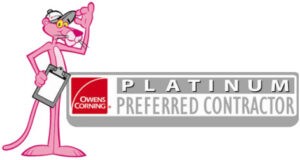The roof on your home or business protects your structure from extreme weather conditions such as high winds, ice, heavy rain, and other weather that can arise. If your roof isn’t durable, you’ll have a much harder time keeping the elements out. However, life expectancy on a roofing system can vary greatly, with asphalt shingle roofs lasting the shortest amount of time compared to many roof replacement materials. An asphalt roof often lasts only 5 to 20 years on average, with a few lasting as long as 30 years while still performing well under severe weather.
By comparison, metal panel roofs last a much longer time, from 20 years up to over a century for high-quality copper roofing. This makes metal roofs a very attractive option for home and business owners. However, this longevity will depend on several factors, including proper installation, proper maintenance, the specific metal roofing material, and the fasteners that are used. A properly installed metal roof can last longer than most people’s lifetimes, making it a great investment as part of your legacy.
In this article, we’ll go over a number of considerations for your high-quality metal roof, including its different parts, the expected lifespan and how to extend it, myths surrounding metal roofs, noise level, heat and energy efficiency, leak concerns, routine maintenance, and how to select the right roofing contractor for your needs.
Parts of a Metal Roof
Though we tend to limit metal roofing parts to the metal panels that make up the roof’s surface, there are actually several other components to take into account:
- Roof Panels: Make up the roof’s surface and prevent rain from entering your structure through the roof decking.
- Flashing: Prevents water from seeping through in vulnerable areas such as valleys, roof-to-wall connections, protrusions, and similar areas.
- Fasteners: Hold your roofing panels and other materials securely to the roof surface, preventing them from loosening up or blowing away.
- Trim: Can cover a wide range of areas, including hip and ridge cap, anchor strips, eave trim, gable trim, open valley trim, sidewall trim, and endwall or sidewall trim, which protect your roof from damage at the edges and connection locations.
Lifespan of Metal Roofs
Metal roofs have an average lifespan between 20 and 50 years, with some lasting over 100 years, approaching the lifespan of clay tile, and far exceeding asphalt and wood shingle roofs. But what are the factors that will impact that longevity? Proper installation, regular maintenance, and weather conditions can all play a part, as can material and thickness.
Working with a qualified contractor who recommends the right metal panel type for your normal weather can help prolong your roof’s lifespan. Though steel roofing tends to be very low maintenance, regular inspections of your new roof ensure that it will hold up well against harsh weather conditions. Regular inspections also allow you to note tree branches growing close to the roof, clogged gutters that can form ice dams, and areas where roofing fasteners have loosened.
Similarly, the type of panel will also impact longevity, with a standing seam metal roof lasting much longer than simple screw-down roofs. This is because this type of panel will expand with temperature changes and contract in colder climates, allowing the roof to move with these changes. Copper metal roofing systems tend to last longer than a steel roof, and thicker gauges of metal will last longer than thinner gauges. By taking these issues into account when selecting your new metal roof, you’ll be able to get a metal roof installation that will last for many years to come.
Myth Debunked: Do Metal Roofs Attract Lightning?
Though metal is conductive, your metal roof is at no more of a risk of lighting strike than any other type of roof in your area. That’s because lighting always seeks the highest point to connect it to the ground. If your metal roof happens to be the highest point in the area, a lightning rod with a connection to the ground will re-route the lighting past your structure and directly to the earth, protecting your structure from damage. Unless your roof is directly connected through metal all the way through your structure to the earth, the lighting will take the path of least resistance offered by the lighting rod and connected cable.
Noise Levels of Metal Roofs
A lot of people think that metal roofs are noisy, and before modern materials, insulation, and similar construction materials were regularly incorporated, they could have been. However, today’s metal roofs are situated over a layer of insulation in your attic, which deadens the sound. In addition to this, if you have particularly sensitive hearing, there are many options that can be undertaken during your installation to reduce the noise even further. Additional attic insulation may help while providing additional energy savings. You could also add a floating deck on your roof structure, which isolates the sound from your home or business.
Heat and Energy Efficiency of Metal Roofs
If you’re worried that many square feet of metal on your roof will increase your heat gain during the summer and raise your air conditioner costs, don’t be. Overall, metal roofs will reflect heat away from your structure, whether you’re going with copper roofing, aluminum roofing, or steel roofing.
This will lower your overall cooling bill because metal roofs also transfer heat, allowing them to cool down very quickly compared to asphalt shingles that may retain heat for many hours after they become shaded. Similarly, the inside surface of the metal roofing will reflect heat back into a structure, lowering the heating bill in the winter. However, if you want to maximize your energy efficiency in the summer, you’ll want to make sure that the protective coating on the surface of the panel is the lightest possible color, which will also reflect heat and sunshine away from your residence.
Addressing Leak Concerns in Metal Roofs
Though leaks are very rare in a properly installed metal roof, they can occur on occasion, but typically only in a few small areas. To start, you’ll need to detect and locate the leak that has developed. You’ll want to start in the highest level of your home, such as your attic, and look for moisture, discoloration, or other signs of leakage. Once you’ve located the leak, you’ll be able to make repairs so that your maintenance costs will remain low.
Loose fasteners can happen after high winds have caused a broken or loosened fastener. Tightening a loose fastener may be sufficient to stop the leak but check the condition of any gaskets and replace them if they are worn. Flashing or trim issues may require peeling up a panel or two in the problem area and making repairs to avoid continued leakage. Perturbances can include vents, chimneys, and other areas where flashing and sealant tends to wear or degrade, requiring new application to stop the leaks.
The most important part of enjoying minimal maintenance of your roof and avoiding leaks is using a roofer who is knowledgeable with the installation techniques for their material. A properly installed roof will always have fewer leaks than one that has been poorly installed. The one exception to this is physical damage caused by tree branches or other debris landing heavily on the roof and causing damage that must be repaired.
Maintenance: How to Clean a Metal Roof
Cleaning debris off of your metal roof ensures that it will not be damaged by it or will not allow water to remain behind a dam of debris, which can lead to ice dams. The most common method is using a pressure washer with a soap mixture, though vinegar or bleach can be added if you’re having issues with algae. Follow the instructions provided when you purchased your new metal roof to ensure that you’re following the manufacturer’s recommendations. This helps with warranty protection if you have an issue down the road.
If you’re going to clean your roof on your own, make sure to take appropriate safety precautions. Make sure to secure your safety harness to a sturdy, stationary object. Ensure that someone will be nearby in case your ladder falls or other issue strands you on the rooftop. If you’re not comfortable cleaning your own roof, there are many services available that can handle the task for you, but your best bet is working with a roofing company that understands the nuances of metal roofing.
Contact Leverage Roofing for Metal Roofing needs!
When you’re buying a metal roof, get the best, thickest material that you can afford that is recommended by roofers in your area. Don’t forget to budget for trim, lightning rods, roof decking repairs or changes, additional insulation, and allow a little extra for issues that can arise on any construction project. By regularly maintaining your metal roof, you’ll get many more years of service out of it. If you need a new roof or roof repair, Leverage Roofing is ready to help, so please contact us today!


